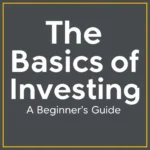Investing is one of the most powerful ways to build wealth over time. However, for beginners, the world of investments can seem complex and overwhelming. From stocks to bonds, mutual funds, and ETFs, each type of investment carries its own risks and rewards. Understanding the basics of investing and developing a strategy that aligns with your financial goals is crucial for long-term success. This article provides an overview of common investment vehicles and offers strategies to help beginners get started on their investment journey.
Why Invest?
Before diving into specific strategies, it’s important to understand why investing is essential. Simply saving money in a traditional savings account may not be enough to build wealth due to inflation, which erodes the purchasing power of your savings over time. Investing allows your money to grow at a faster rate, potentially outpacing inflation and helping you achieve financial goals like retirement, buying a home, or funding a child’s education.
Key Investment Options for Beginners
- Stocks (Equities)
- What are they?: Stocks represent ownership in a company. When you purchase a stock, you’re buying a small share of that company. If the company performs well, the value of your stock may increase, and you may also receive dividends (a portion of the company’s profits).
- Risk/Reward: Stocks generally offer higher returns compared to other types of investments, but they also come with higher risks. Stock prices can be volatile, especially in the short term, and there’s no guarantee of profit.
- Who should invest?: Stocks are ideal for investors with a higher risk tolerance and a long-term investment horizon. If you’re planning to invest for retirement or other goals 10+ years away, stocks are a good option.
- Bonds
- What are they?: Bonds are essentially loans you give to governments or corporations. In return, the issuer agrees to pay you back the principal amount along with interest over a set period.
- Risk/Reward: Bonds are generally considered safer than stocks, especially government bonds (like U.S. Treasury bonds). However, their returns are typically lower. Corporate bonds may offer higher interest rates, but they come with more risk, especially if the company’s financial health is unstable.
- Who should invest?: Bonds are suited for more conservative investors or those nearing retirement who want to preserve capital and receive steady income from interest.
- Mutual Funds
- What are they?: A mutual fund pools money from multiple investors to invest in a diversified portfolio of stocks, bonds, or other securities. The fund is managed by a professional fund manager who makes investment decisions on behalf of the investors.
- Risk/Reward: The risk and reward of mutual funds depend on the assets they invest in. Stock mutual funds are riskier but offer higher potential returns, while bond mutual funds are generally safer but provide lower returns. The primary advantage of mutual funds is diversification, which helps spread risk.
- Who should invest?: Mutual funds are great for beginners because they offer instant diversification and are managed by professionals. They are also ideal for investors who prefer a hands-off approach to managing their portfolio.
- Exchange-Traded Funds (ETFs)
- What are they?: ETFs are similar to mutual funds but trade on stock exchanges like individual stocks. ETFs typically track an index (such as the S&P 500) and offer a simple way to invest in a wide variety of assets with a single purchase.
- Risk/Reward: ETFs provide the benefits of diversification, similar to mutual funds, but often have lower fees. The risk depends on the type of ETF (stocks, bonds, or a mix of both). ETFs are usually less risky than individual stocks but can be more volatile than bonds.
- Who should invest?: ETFs are ideal for investors who want low-cost, diversified investments. They are suitable for both beginners and more experienced investors.
- Real Estate Investment Trusts (REITs)
- What are they?: REITs are companies that own, operate, or finance income-producing real estate. Investing in REITs allows you to invest in real estate without having to buy property directly.
- Risk/Reward: REITs offer higher dividend yields than many stocks and bonds but can be volatile, especially during economic downturns that affect the real estate market. However, they can be a good way to diversify your portfolio with exposure to real estate.
- Who should invest?: Investors looking for a steady income from dividends and exposure to the real estate market might consider REITs.
Developing a Beginner Investment Strategy
- Start with Clear Financial Goals
- Before you start investing, it’s important to have clear financial goals. Are you saving for retirement, building an emergency fund, or looking to make a large purchase in the future? Your goals will determine your investment time horizon and risk tolerance.
- Assess Your Risk Tolerance
- Risk tolerance is your ability to endure fluctuations in the value of your investments. If you can handle short-term losses in exchange for potential long-term gains, you might have a higher risk tolerance and prefer stocks. If you’re more conservative, you might prefer bonds or other low-risk investments. Knowing your risk tolerance helps you choose the right investment mix.
- Diversify Your Investments
- One of the most important strategies for managing risk is diversification. This means spreading your investments across different asset classes (stocks, bonds, real estate, etc.) and sectors (technology, healthcare, energy, etc.). Diversification reduces the impact of a poor-performing investment on your overall portfolio.
- Invest for the Long Term
- The stock market and other investments can be volatile in the short term, but over the long term, they tend to grow. By investing with a long-term perspective, you can ride out market fluctuations and take advantage of compound interest, which significantly increases returns over time.
- Automate Your Investments
- Many investment platforms allow you to set up automatic contributions to your investment accounts. This strategy, called dollar-cost averaging, ensures that you’re investing consistently, regardless of market conditions. It also reduces the temptation to time the market, which can lead to poor investment decisions.
- Start with Low-Cost Index Funds
- For beginners, low-cost index funds and ETFs are often the best place to start. These funds track market indexes, such as the S&P 500, and offer broad exposure to the stock market. Since they’re passively managed, their fees are typically much lower than actively managed mutual funds, which helps maximize your returns.
- Review and Adjust Your Portfolio Regularly
- Over time, your financial situation and goals may change, and your portfolio should reflect that. It’s important to review your portfolio at least once a year to ensure that it still aligns with your investment strategy and risk tolerance. Rebalancing your portfolio can help maintain your desired asset allocation.
Common Mistakes to Avoid
- Timing the Market: Trying to predict when the market will rise or fall can lead to poor investment decisions. Instead, focus on long-term growth and invest consistently.
- Chasing Hot Stocks: Avoid the temptation to invest in trending stocks or sectors without understanding the risks. What’s popular today may not perform well in the future.
- Neglecting Fees: High fees can eat into your returns over time. Be mindful of the fees associated with mutual funds, ETFs, and investment platforms, and opt for low-cost options when possible.
Conclusion
Investing is one of the best ways to grow your wealth and achieve financial goals, but it’s important to approach it with a well-thought-out strategy. For beginners, the key is to start with clear financial goals, assess your risk tolerance, and build a diversified portfolio with a mix of stocks, bonds, and other investment vehicles. By investing for the long term, automating contributions, and avoiding common pitfalls, you can set yourself up for financial success. With time and patience, even small investments can grow into substantial wealth.










